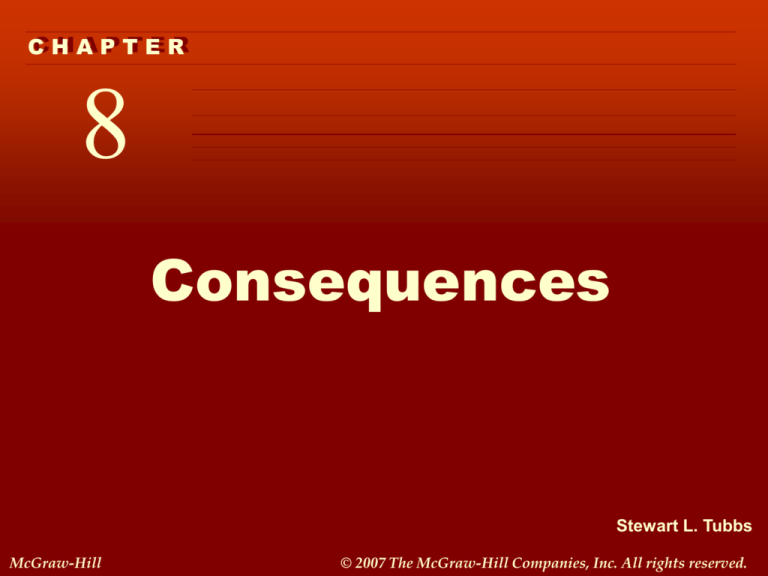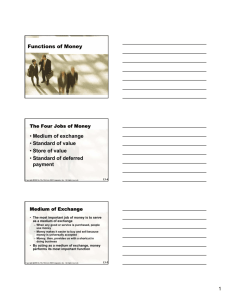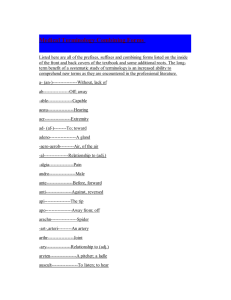
CH
HA
A PP TT EE R
R
C
8
Consequences
Stewart L. Tubbs
McGraw-Hill
© 2007 The McGraw-Hill Companies, Inc. All rights reserved.
Slide 2
Consequences
•
•
•
•
•
McGraw-Hill
Solutions to Problems
Changes in Interpersonal Relations
Improved Information Flow
Organizational Change
Review of the Systems Approach
© 2007 The McGraw-Hill Companies, Inc. All rights reserved.
Slide 3
Solutions to Problems
• Quality of Solutions
– Groups have the potential to make better-quality
decisions than the same individuals would make
if working alone.
• In those instances when group performance does not
surpass individual performance, the group process
has been counterproductive.
McGraw-Hill
© 2007 The McGraw-Hill Companies, Inc. All rights reserved.
Slide 4
Solutions to Problems
• Quality of Solutions
– Teams can help increase value:
• By performing the same function at a lower cost.
• By increasing function while reducing costs.
• By increasing function while increasing costs by a
proportionally smaller amount.
• By decreasing function while decreasing cost by a
proportionally greater amount.
– It has been found that groups are better at
solving complicated tasks requiring reasoning
and elimination of poor solutions.
McGraw-Hill
© 2007 The McGraw-Hill Companies, Inc. All rights reserved.
Slide 5
Solutions to Problems
• Quality of Solutions
– Groups are altering their form with changes in
geography, tighter budgets, increased
technology, and the global search for the very
best subject matter experts.
– Virtual groups have evolved and specific teams
skills and dynamics are necessary to achieve
high quality solutions.
McGraw-Hill
© 2007 The McGraw-Hill Companies, Inc. All rights reserved.
Slide 6
Solutions to Problems
• Acceptance of Solutions
– For solutions to be effective, they must be of
high quality and they must be accepted by those
who must carry them out.
McGraw-Hill
© 2007 The McGraw-Hill Companies, Inc. All rights reserved.
Slide 7
Solutions to Problems
• Acceptance of Solutions
Three types of problem situations can be identified:
– Problems requiring high quality but low
acceptance are best solved by persons with a
high level of technical knowledge and
expertise.
– Problems requiring high acceptance but low
quality may include all individuals who may
be affected by the results of the decision.
– Problems requiring high quality and high
acceptance should utilize problem-solving
groups.
McGraw-Hill
© 2007 The McGraw-Hill Companies, Inc. All rights reserved.
Slide 8
Solutions to Problems
• Acceptance of Solutions
– People generally are resistant to changes that
affect their lives, especially if these changes are
initiated by others.
– Group decision making and “people
involvement” can be powerful assets in
increasing satisfaction and overcoming
resistance to change.
McGraw-Hill
© 2007 The McGraw-Hill Companies, Inc. All rights reserved.
Slide 9
Solutions to Problems
• Acceptance of Solutions
– There are several factors to remember in
overcoming resistance to change.
• People will accept changes that they have a part in
planning.
• Changes will be accepted if they do not threaten our
security.
• Changes will be more readily accepted when people
are involved in gathering the facts that indicate the
need for change.
• Greater acceptance and commitment will result when
the changes are kept open to further revision based
on the success or failure of the new procedures.
McGraw-Hill
© 2007 The McGraw-Hill Companies, Inc. All rights reserved.
Slide 10
Solutions to Problems
• Acceptance of Solutions
– For long-term success, teams must function in a
responsible manner, and management must
possess a high degree of trust and confidence in
the system.
McGraw-Hill
© 2007 The McGraw-Hill Companies, Inc. All rights reserved.
Slide 11
Changes in Interpersonal Relations
• Meetings designed to share perceptions of
one another to inform each other of
particular problems can potentially clear up
and reduce areas of misperception and
misunderstanding.
• Cohesion is a result of group interaction, but
it in turn influences other things
• Small group interaction has the potential of
increasing interpersonal relations and
cohesiveness.
McGraw-Hill
© 2007 The McGraw-Hill Companies, Inc. All rights reserved.
Slide 12
Changes in Interpersonal Relations
• Team Building
– Larson and LaFasto (1989) identified eight
dimensions of team excellence:
1. Clear, evaluating goal
2. Results-driven structure
3. Competent team members
4. Unified commitment
5. Collaborative climate
6. Standards of excellence
7. External support and recognition
8. Principled leadership
McGraw-Hill
© 2007 The McGraw-Hill Companies, Inc. All rights reserved.
Slide 13
Changes in Interpersonal Relations
• Team Building
– Heathfield (2005) offers twelve tips for successful
team building:
1.
2.
3.
4.
5.
6.
McGraw-Hill
Clear expectations
Context
Commitment
Competence
Charter
Control
© 2007 The McGraw-Hill Companies, Inc. All rights reserved.
Slide 14
Changes in Interpersonal Relations
•
Team Building
– Heathfield (2005) offers twelve tips for successful
team building:
7.
8.
9.
10.
11.
12.
McGraw-Hill
Collaboration
Communication
Creative Innovation
Consequences
Coordination
Cultural Change
© 2007 The McGraw-Hill Companies, Inc. All rights reserved.
Slide 15
Changes in Interpersonal Relations
•
Virtual Team Building
– Virtual groups and teams can benefit fro
team building.
– Virtual teams cuts down on travel costs
and saves money.
McGraw-Hill
© 2007 The McGraw-Hill Companies, Inc. All rights reserved.
Slide 16
Improved Information Flow
• Communication in small groups can result in
an increased knowledge level and increased
coordination among group members based
on the sharing of information.
• Rogers (1995) finds that some people by
nature are earlier adopters of new ideas
whereas others are more resistant to change.
McGraw-Hill
© 2007 The McGraw-Hill Companies, Inc. All rights reserved.
Slide 17
Improved Information Flow
• Another factor is the tendency for subgroups
to form so that information that passes
between groups is restricted.
– Lawrence and Lorsch (1969) have referred to
problems of this nature as differentiationintegration problems.
McGraw-Hill
© 2007 The McGraw-Hill Companies, Inc. All rights reserved.
Slide 18
Improved Information Flow
• Adopter Categorization on the Basis of
Innovativeness
McGraw-Hill
© 2007 The McGraw-Hill Companies, Inc. All rights reserved.
Slide 19
Organizational Change
• The Ten Commandments of Implementing
Changes:
1. Analyze the organization and its need for
change.
2. Create a shared vision and common direction.
3. Separate from the past.
4. Create a sense of urgency.
5. Support a strong leader role.
McGraw-Hill
© 2007 The McGraw-Hill Companies, Inc. All rights reserved.
Slide 20
Organizational Change
• The Ten Commandments
6. Line up political sponsorship.
7. Craft an implementation plan.
8. Develop enabling structures.
9. Communicate, involve people, and be honest.
10. Reinforce and institutionalize change.
McGraw-Hill
© 2007 The McGraw-Hill Companies,Source:
Inc. AllJick,
rights
1993,
reserved.
p. 195.
Slide 21
Organizational Change
• Peter Drucker (1999) has offered the
following advice for leaders on managing
change:
1. Introduce change on a small scale.
2. Budget for change.
3. Balance change and continuity.
McGraw-Hill
© 2007 The McGraw-Hill Companies, Inc. All rights reserved.
Slide 22
Organizational Change
McGraw-Hill
© 2007 The McGraw-Hill Companies, Inc. All rights reserved.
Slide 23
Organizational Change
• The Strategic Doom Cycle
McGraw-Hill
© 2007 The McGraw-Hill Companies, Inc. All rights reserved.
Slide 24
Organizational Change—
Practical Tips
Hitchcock and Willard (1995) offer the following
practical tips for using teams to help create
organizational change.
– The business concept must be viable.
– Recognize that the right to make a decision is separate
from the competency to implement it.
– Clarify what decisions should be made at certain levels,
and establish a mechanism to move decisions among
these levels.
McGraw-Hill
© 2007 The McGraw-Hill Companies, Inc. All rights reserved.
Slide 25
Organizational Change—
Practical Tips
• Hitchcock and Willard
– Codify the principles that will guide you, and establish a
mechanism to hold everyone accountable for carrying
out those principles.
– Devise a system for resolving conflicts and differences.
– Establish an equitable way for distributing profits or
rewards that is consistent with the egalitarian nature of
democracy.
McGraw-Hill
© 2007 The McGraw-Hill Companies, Inc. All rights reserved.
Slide 26
Organizational Change
• Rogers (1995) and his colleagues found that
people accept change along a distribution
that is a bell-shaped curve.
–
–
–
–
–
McGraw-Hill
Innovators
Early adopters
Early majority
Late majority
Laggards
© 2007 The McGraw-Hill Companies, Inc. All rights reserved.
Slide 27
Review of the Systems Approach
• Four potential consequences of group
interaction are: (1) solutions to problems,
(2) changes in interpersonal relations,
(3) improved information flow, and
(4) organizational change.
• Small group interaction must be viewed as a
system of interrelated variables in which a
change in any one variable creates changes
in the other variables in the system.
McGraw-Hill
© 2007 The McGraw-Hill Companies, Inc. All rights reserved.
Slide 28
Review of the Systems Approach
• Information flow may be improved as a
result of interaction; but with a highly
structured communication network and
authoritarian leadership, communication
flow might actually diminish.
• Numerous studies have shown that it takes a
comprehensive (systems) approach to
successfully create large-scale
organizational change.
McGraw-Hill
© 2007 The McGraw-Hill Companies, Inc. All rights reserved.







